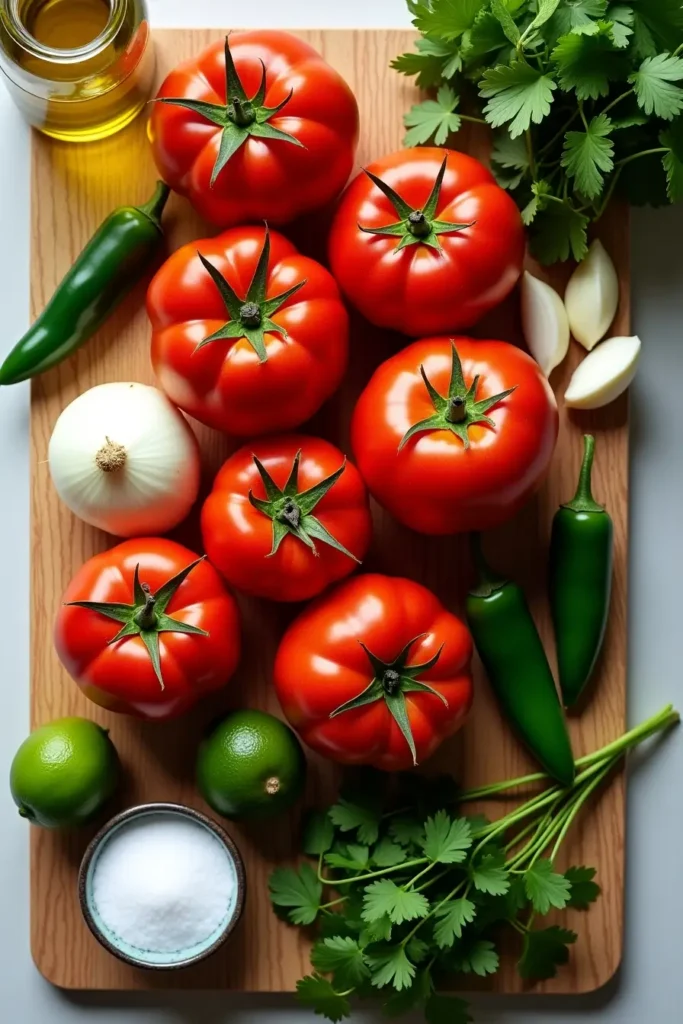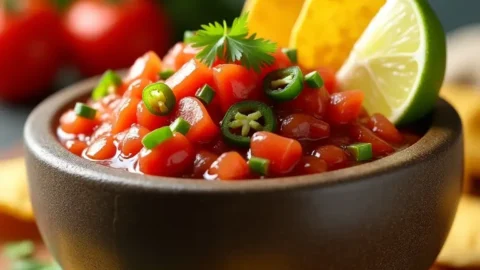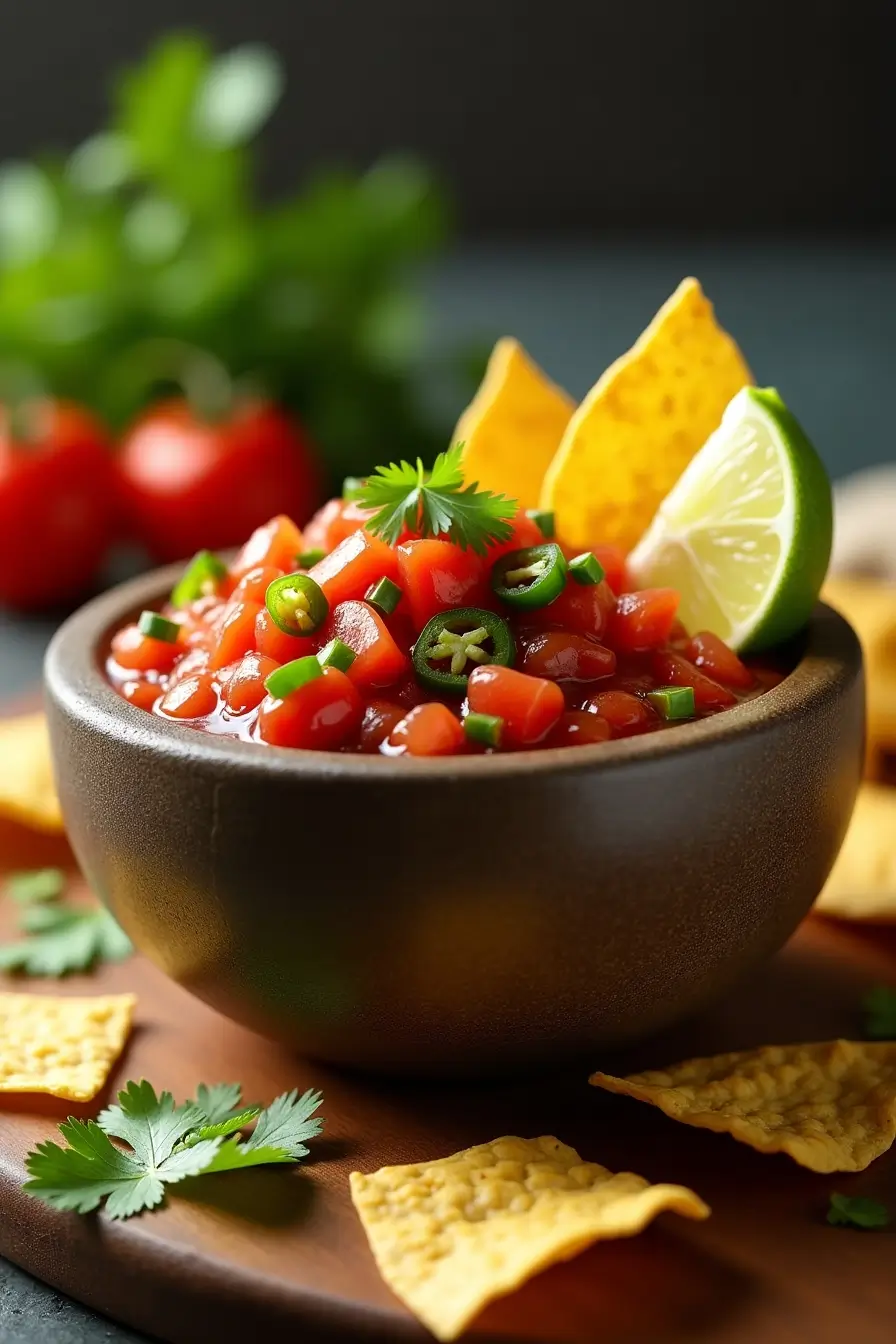Table of Contents
Last night, as I stood in my kitchen staring at a pile of ripe tomatoes from my neighbor’s garden, I remembered my grandmother’s words: “A fresh salsa can save any meal.” Growing up in Arizona, homemade salsa wasn’t just a condiment in our house it was practically a food group! That memory inspired me to whip up a batch of homemade salsa right then and there, and I was reminded how incredibly simple yet transformative this recipe is.
If you’ve been reaching for store-bought jars of salsa, I’m about to change your taco night forever. This homemade salsa recipe takes just 10 minutes to prepare but delivers such vibrant flavors that you’ll wonder why you ever settled for the processed stuff. The best part? You probably already have most of the ingredients sitting in your kitchen right now.
What makes this homemade salsa special isn’t just its fresh taste it’s the perfect balance of acidity, heat, and herbaceous notes that you can customize to your exact preferences. Unlike many restaurant versions loaded with sodium and preservatives, this recipe gives you complete control over what goes into your dip.
Ingredients Breakdown & Substitutions
The beauty of homemade salsa lies in its simplicity and flexibility. Here’s everything you’ll need:

- 4 medium ripe tomatoes – Roma or vine-ripened work best for their flavor concentration. If tomatoes aren’t in season, you can substitute 1 (14 oz) can of fire-roasted diced tomatoes for a deeper flavor.
- 1 small white onion – Provides sharpness and texture. Yellow onions work too but have a stronger flavor. For a milder option, try green onions or shallots.
- 2-3 jalapeños – Adjust according to your heat preference. Remove seeds and membranes for milder salsa, or substitute with ½ poblano pepper for very mild salsa. For extra heat, try 1 serrano pepper instead.
- 3 garlic cloves – Adds depth and complexity. If you don’t have fresh, substitute with ½ teaspoon garlic powder, though fresh is preferred for authentic homemade salsa flavor.
- ¼ cup fresh cilantro leaves – The signature flavor enhancer in traditional homemade salsa. If you’re in the “cilantro tastes like soap” camp, substitute with fresh parsley or a tablespoon of dried oregano.
- Juice of 1 lime – Provides essential acidity. Lemon juice works in a pinch, or try 1 tablespoon of white vinegar for a different tang profile.
- ½ teaspoon salt – Kosher or sea salt is preferable. Adjust to taste.
- ¼ teaspoon ground cumin – Adds earthy warmth. Optional but recommended for authentic homemade salsa flavor.
- 1 tablespoon olive oil – A little fat helps carry flavors. Avocado oil makes a great substitute.
For those with dietary restrictions, this homemade salsa is naturally vegan, gluten-free, dairy-free, and keto-friendly. The ingredients are readily available at any grocery store, with peak flavor during summer tomato season.
Step-by-Step Instructions with Expert Tips
Let’s break down how to make perfect homemade salsa in just 10 minutes:
- Prep your vegetables. Roughly chop tomatoes, onion, jalapeños, garlic, and cilantro. Pro tip: Don’t over-chop before blending a few pulses will give you the perfect chunky homemade salsa texture.
- Add to food processor or blender. Start with garlic, onion, and jalapeños. Important step: Pulse these ingredients first before adding tomatoes this ensures the aromatics are properly broken down while allowing you to control the tomato texture.
- Pulse 3-5 times until ingredients are roughly chopped but not pureed. Troubleshooting tip: If mixture is too dry to blend properly, add 1 tablespoon of water or lime juice.
- Add tomatoes, cilantro, lime juice, salt, and cumin. Pro tip: Hold back half the tomatoes if you prefer a chunkier homemade salsa, adding them in the final pulses.
- Pulse 5-7 more times until desired consistency is reached. Key action: Stop and scrape down sides between pulses for even texture.
- Stir in olive oil by hand after blending. Expert insight: Adding oil after processing prevents the salsa from developing a cloudy appearance.
- Taste and adjust seasonings. This is where the magic happens! Add more lime juice for tang, salt for flavor enhancement, or jalapeño for heat. Remember: Homemade salsa flavors develop and deepen after sitting for at least 15 minutes.
- Transfer to serving bowl and let rest for 15 minutes before serving, if time allows. This resting period allows the homemade salsa flavors to marry perfectly.
Total active time: Just 10 minutes from start to finish!
Why This Recipe Is a Must-Try
- Quick and Easy – Goes from ingredients to table in 10 minutes flat
- Cost-Effective – Significantly cheaper than premium store brands
- Fresher Taste – No preservatives or artificial flavors like commercial versions
- Customizable – Adjust heat, texture, and flavors to your exact preference
- Impressive – Watch friends ask for your homemade salsa recipe at every gathering
- Healthier Option – Control sodium levels and avoid additives
- Versatile – Works as a dip, sauce, or topping for countless meals
- Uses Common Ingredients – No specialty items required
- Make-Ahead Friendly – Actually improves with a little time in the fridge
- Elevated Everyday Meals – Transforms simple dishes into something special
Storage, Make-Ahead & Freezing Tips
Homemade salsa actually improves after sitting for a day, making it perfect for advance preparation. Here’s how to handle leftovers:
- Refrigerator Storage: Store homemade salsa in an airtight container in the refrigerator for up to 7 days. The acidity from the lime juice acts as a natural preservative. I find mason jars work perfectly for this purpose.
- Make-Ahead Option: For best flavor development, make your homemade salsa up to 24 hours before serving. This allows the ingredients to meld together while maintaining freshness.
- Freezing Instructions: While you can freeze homemade salsa for up to 3 months, the texture will change upon thawing, becoming slightly softer. I recommend freezing in ice cube trays, then transferring the frozen cubes to freezer bags perfect for dropping into soups and chilis.
- Reviving Leftovers: If your homemade salsa gets watery after a few days (which happens naturally as the salt draws moisture from the vegetables), simply drain off excess liquid or stir in half an avocado to restore creaminess.
Last summer, I made a double batch of this homemade salsa before a week-long beach vacation. We used it throughout the week first as a dip with chips, then as a topping for grilled fish tacos, and finally stirred into scrambled eggs on our last morning. The flavor actually improved each day!
Creative Variations & Serving Ideas
Once you’ve mastered basic homemade salsa, try these exciting variations:
Flavor Twists:
- Roasted Homemade Salsa – Char vegetables under the broiler for 5 minutes before processing for smoky depth
- Tropical Homemade Salsa – Add ½ cup diced pineapple or mango for sweetness
- Avocado Homemade Salsa – Blend in one ripe avocado for creamy texture
- Black Bean & Corn Homemade Salsa – Stir in ½ cup each of black beans and corn after blending
- Fermented Homemade Salsa – For adventurous eaters, allow to ferment at room temperature for 2-3 days before refrigerating
Perfect Pairings:
- Classic tortilla chips
- Grilled fish tacos
- Scrambled eggs or omelets
- Baked potatoes
- Grilled chicken or steak
- Quesadillas
- Rice bowls
- Salad topper (use as dressing)
- Mixed with Greek yogurt for a quick dip
- Stirred into soups for instant flavor boost
My personal favorite way to serve homemade salsa is spooned over a simple cheese quesadilla with a side of sliced avocado it transforms a 5-minute meal into something restaurant-worthy!
Nutrition Value
| Nutrient | Amount per ¼ cup serving |
| Calories | 35 |
| Protein | 1g |
| Carbohydrates | 5g |
| Fat | 1.5g (mostly unsaturated) |
| Fiber | 1g |
| Sugar | 3g (all naturally occurring) |
| Vitamin C | 15% DV |
| Vitamin A | 10% DV |
Dietary Considerations:
- Gluten-free
- Dairy-free
- Vegan
- Low-calorie
- Keto-friendly
- Paleo-compatible
Nutrition values calculated using the USDA Food Database. Values are approximate and may vary based on specific ingredients used.
This homemade salsa provides significant vitamin C from the tomatoes and jalapeños, making it not just delicious but nutritious as well. The minimal calories mean you can enjoy it generously without guilt!
Expert Tips
After making homemade salsa weekly for over a decade, I’ve learned some tricks that make all the difference:
- Temperature matters – Always serve homemade salsa at room temperature, not straight from the refrigerator. Cold temperatures dull the flavor complexity.
- Proper tomato preparation – If using fresh tomatoes, remove some seeds and excess juice before blending to prevent watery salsa. However, don’t remove all seeds as they contain valuable umami flavor compounds.
- The “hand chop” option – For restaurant-style texture, try hand-chopping all ingredients instead of using a food processor. This creates distinct flavor pockets in every bite of your homemade salsa.
- Aromatics first – Always process garlic and onions first to ensure they’re properly broken down, preventing unexpected chunks of intense flavor.
- The salt timing secret – Add salt to chopped tomatoes 5 minutes before blending to draw out moisture and intensify flavor in your homemade salsa.
- Acid balance is key – If your homemade salsa tastes flat, it typically needs more acidity rather than salt. Try an extra squeeze of lime before adding more sodium.
- Controlling heat level – Jalapeño heat varies tremendously from pepper to pepper. Always taste a tiny piece before adding to gauge spiciness.
I once served a batch of homemade salsa that was accidentally made with extra-hot jalapeños. My quick fix? I blended in half an avocado and an extra tomato, which balanced the heat perfectly while creating a delicious creamy variation!
FAQs
Q: How long does homemade salsa last in the refrigerator?
A: When properly stored in an airtight container, homemade salsa will last 5-7 days in the refrigerator. You’ll know it’s fresh if the colors remain vibrant and there’s no unusual smell.
Q: Can I make homemade salsa without cilantro?
A: Absolutely! If you’re among the approximately 20% of people with the genetic predisposition that makes cilantro taste soapy, substitute with fresh parsley, a smaller amount of dried oregano, or simply omit it entirely. Your homemade salsa will still be delicious!
Q: Why is my homemade salsa too watery?
A: Excess water typically comes from the tomatoes. Try removing some seeds and juice before blending, using paste tomatoes like Roma which are less watery, or straining the finished salsa. You can also add a quarter of an avocado to absorb extra moisture.
Q: Can I use canned tomatoes for homemade salsa?
A: Yes! In winter months when fresh tomatoes lack flavor, a 14oz can of fire-roasted diced tomatoes makes an excellent substitute. Drain about half the liquid before using, and reduce or eliminate any added salt since canned tomatoes contain sodium.
Q: Is homemade salsa healthier than store-bought?
A: Generally yes! Homemade salsa contains no preservatives, significantly less sodium, and higher levels of vitamins since it uses fresh ingredients. Plus, the flavor is incomparably better!
Conclusion
There’s something deeply satisfying about setting out a bowl of homemade salsa you’ve made yourself. Beyond the superior taste and nutrition, it connects us to culinary traditions that have brought people together for generations. This 10-minute recipe proves that authentic, delicious food doesn’t require complicated techniques or hours in the kitchen.
I’d love to know how your homemade salsa turns out! What adjustments did you make to suit your taste preferences? Did you try any of the variations?
If you loved this, check out my Honey Lime Chicken or Peruvian Grilled Chicken ! Don’t forget to subscribe to my newsletter for more globally inspired seafood recipes delivered straight to your inbox, and follow me on PINTEREST TidbitRecipe where I share behind the scenes cooking tips and kitchen experiments!
Remember, the best recipes are the ones you make your own. Happy cooking!

Quick Homemade Salsa
Equipment
- Food Processor
Ingredients
Salsa Ingredients
- 4 medium ripe tomatoes
- 1 small white onion
- 2-3 jalapeños
- 3 garlic cloves
- 1/4 cup fresh cilantro leaves
- 1 lime juiced
- 1/2 tsp salt
- 1/4 tsp ground cumin
- 1 tbsp olive oil
Instructions
- Roughly chop tomatoes, onion, jalapeños, garlic, and cilantro.
- Add garlic, onion, and jalapeños to food processor and pulse 3–5 times.
- Add tomatoes, cilantro, lime juice, salt, and cumin.
- Pulse 5–7 more times until desired consistency is reached.
- Stir in olive oil by hand.
- Taste and adjust seasonings as needed.
- Let rest for 15 minutes before serving if time allows.

